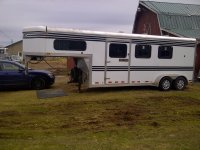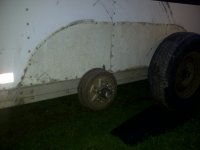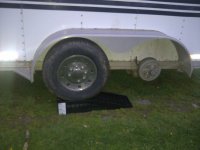gsganzer
Elite Member
- Joined
- Jun 11, 2003
- Messages
- 3,103
- Location
- Denton, TX
- Tractor
- L3800 w/FEL and BH77, BX 2200 w/FEL and MMM
My 3 horse slant is being raised as I write this. They're raising it 4 inches using a 4" square tube spacer under the torsion axles.
My trailer's a 1990 Sooner all-aluminum that started it's life as a stock trailer. It looks like a previous owner then replaced the spring axles with torsion axles with brakes on both axles. It's actually been a great pulling trailer and is pretty stout for an aluminum trailer. But it always had some weird dimensions. The rear always rode low and the front barely had enough clearance over a 3/4 ton bed. Raising it 4 inches should put it back to "normal" dimensions so it provides better clearance.
My trailer's a 1990 Sooner all-aluminum that started it's life as a stock trailer. It looks like a previous owner then replaced the spring axles with torsion axles with brakes on both axles. It's actually been a great pulling trailer and is pretty stout for an aluminum trailer. But it always had some weird dimensions. The rear always rode low and the front barely had enough clearance over a 3/4 ton bed. Raising it 4 inches should put it back to "normal" dimensions so it provides better clearance.


